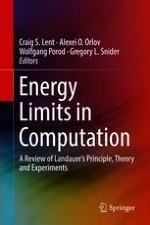
2019 | OriginalPaper | Buchkapitel
Information and Entropy in Physical Systems
verfasst von : Craig S. Lent
Erschienen in: Energy Limits in Computation
Aktivieren Sie unsere intelligente Suche, um passende Fachinhalte oder Patente zu finden.
Wählen Sie Textabschnitte aus um mit Künstlicher Intelligenz passenden Patente zu finden. powered by
Markieren Sie Textabschnitte, um KI-gestützt weitere passende Inhalte zu finden. powered by